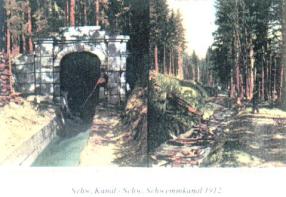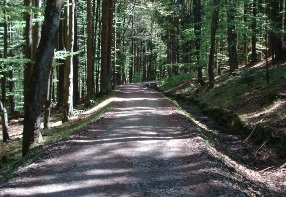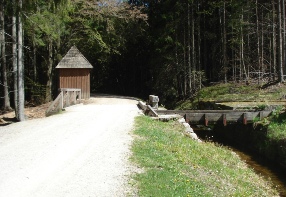Schwarzenberský plavební kanál (Schwarzenberg Floating Canal)
The Schwarzenberg Floating Canal is an artificially built navigational channel connecting one of the tributaries of the Studená Vltava with the Austrian river Grosse Mühl, thus interconnecting the area which feeds the North Sea (the Vltava catchment area) and the area which feeds the Black Sea (the Danube catchment area). In vicinity of the village of Jelení Vrchy the canal goes through about 389 m long tunnel. The total length of the canal is about 44 km and its super-elevation is 255 metres.
The floating canal was built in 1789 to 1822 according to the project of the Schwarzenberg's forestry expert Ing. Josef Rosenauer (*1735 – †1804) from 1775. The canal got its name "Schwarzenberg" after the owners of the Šumava estates of the period - the Schwarzenberg family. A museum focused on this unique technical monument can be found in the native village of Josef Rosenauer - Chvalšiny.
The objective of the floating canal was to enable transport of fire-wood from the inaccessible parts of the Šumava mountains to Vienna, the capital of the Austrian-Hungarian Empire. Thanks to this unequalled structure at the time it was possible to transport timber from the Šumava to Vienna in only eight days.
The floating canal was built in two stages. In the first stage (1789-1793), so-called "old channel" of over 31 km was built under the direction of the project author, engineer Josef Rosenauer, which led from the estuary of the Zwettlbach stream (to the Grosse Mühl river) to the settlement of Jelení Vrchy. The second stage of the construction, so-called "new channel", was built in 1821-1822 under the direction of engineers Falta and Kraus and extended the channel from Jelení Vrchy to Rosenauer water reservoir (at the altitude of 916 m) at the foot of Třístoličník mountain. This second stage included building of the unique tunnel below Plešivec hill (nearby Jelení Vrchy).
To enable smooth transport of the logs it was necessary to ensure enough water, which is why a system of the connection of 27 streams, 3 water reservoirs and Plešné Lake had to be developed.
Eight million cubic metres of fire-wood in total was transported from the Šumava to Vienna over the century of the "golden times" of timber floating from 1793 to 1892. Josef Rosenauer was later awarded freedom of the city of Vienna for his merits in timber-supply.
Certain parts of this technical monument have been reconstructed, in particular about a 11 kilometres-long section between Jelení Vrchy and the detour from Želnavský smyk, a 1,8 kilometre-long section from Bavarian border to the Stocký (Ježový) stream and a 2,5 kilometre-long section between the boundary Ježová/Iglbach stream and the main European drainage divide in the former village of Růžový Vrch. At these sections it is possible to see demonstrations of timber floating several times in a year.



